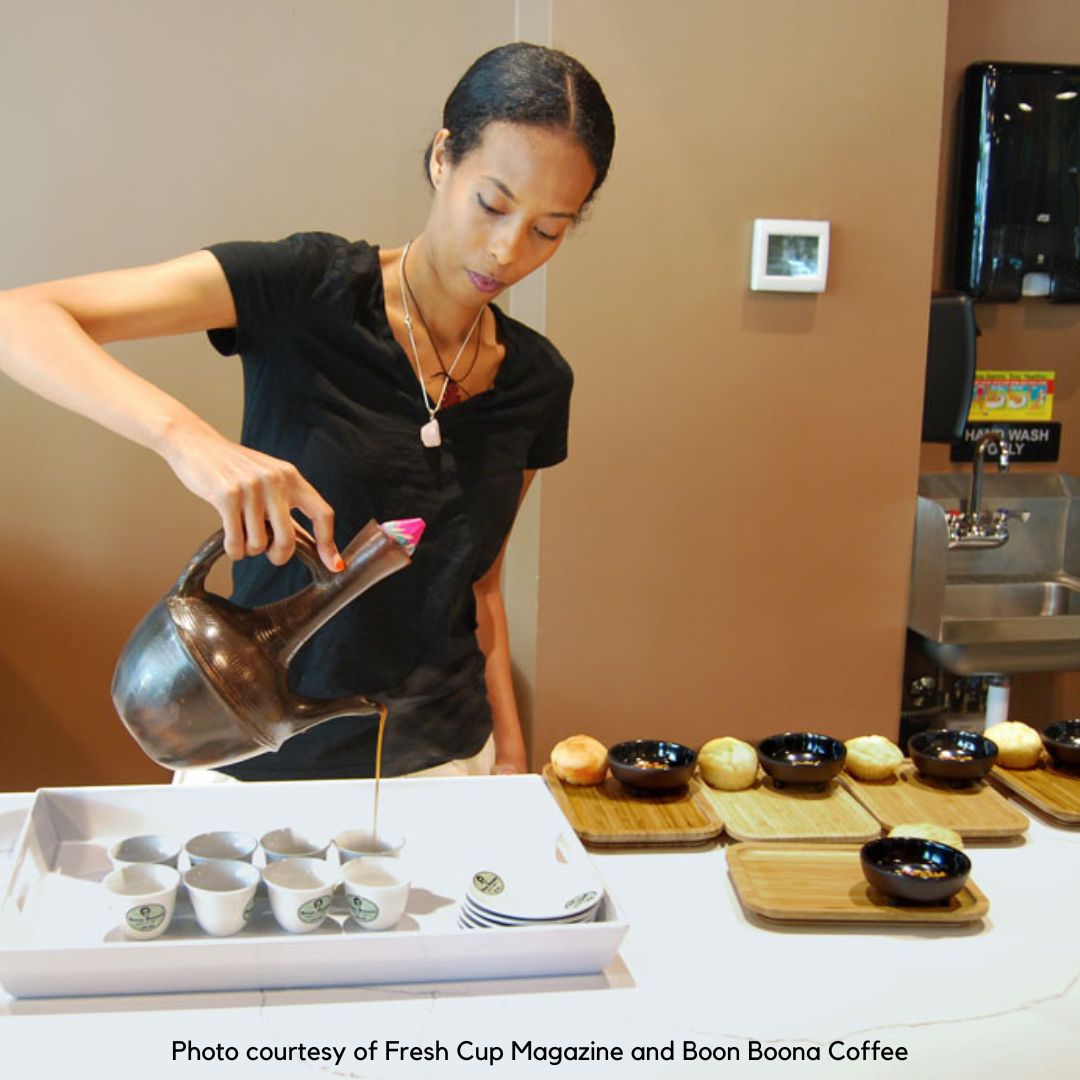The lore of Ethiopian coffee and the traditional coffee ceremony

The Ethiopian Coffee Ceremony is steeped in tradition and history and begins with the story of how coffee was discovered in Ethiopia. The legend goes like this – a goatherd named Kaldi was herding his goats when he discovered they were grazing on a peculiar, unknown plant. The goats began to bleat loudly, frolic and jump about as if strangely dancing. Kaldi discovered the source of their excitement was a small shrub with red berries. He sampled the berries for himself and also felt their stimulating effects.
Astounded, Kaldi gathered some of the berries and brought them home to his wife. She considered them “heaven sent” and advised him to share the berries with the nearby monks of monastery.
However, the monks did not receive Kaldi warmly there. In fact, one monk referred to his coffee beans as "the Devil's work" and tossed them into the fire. The aroma that wafted up from the roasting beans caught the attention of several monks, and they removed the beans from the fire and crushed them to extinguish the embers. In an attempt to preserve them, they put them in an pitcher filled with hot water.
More monks were attracted by the aroma of the brewing coffee. After trying it, they experienced the energizing effects for themselves and continued to drink it to keep them awake during prayers and devotions.
The Ethiopian coffee ceremony is an important part of Ethiopian culture. It involves several steps and three rounds.
The 2-3 hour ceremony is performed by the woman of the house, and is considered the most important social occasion in many regions. It is not only done for special celebrations, and welcoming guests into the home, but the coffee ceremony is such an integral part of their day it is done morning, noon, and evening each day. It is regarded as a sign of respect and friendship to be invited to a coffee ceremony where guests discuss a wide variety of topics from politics to gossip, but also includes tribute to the ceremony performer and her brew.
The ceremony usually follows a specific format and plays both a social and spiritual role that emphasizes the importance of the Ethiopian coffee culture. It is said that as a result of coffee’s spiritual properties, the spirit is also transformed during the three rounds of the coffee ceremony.
The ceremony begins with the hostess preparing the room by spreading fresh aromatic grasses and flowers across the floor and burning incense to ward off evil spirits. The incense is burned throughout the ceremony.
Next she fills a jebena - a black clay coffeepot - with water and places it over hot coals. She then takes a handful of green (unroasted) coffee beans and carefully cleans them in a heated, long-handled, wok-like pan by holding the pan over a small fire, and stirring and shaking the husks and debris out of the beans until they are clean.
Once the beans are clean, she slowly roasts them in the same pan. Her goal is to keep the roast as even as possible. She does this by shaking the beans (much like one would shake an old-fashioned popcorn popper) or stirring them constantly. Roast level is chosen by the hostess. Some choose a medium roast just after first crack, others choose a dark roast where the beans become black and oily. The aroma from roasting is powerful and considered to be an important aspect of the ceremony.
Using a mukecha (pronounced moo-key-cha) a small, heavy wooden bowl - similar to a mortar, and a zenezena, a wooden or metal cylinder with a blunt end - similar to a pestle, the hostess will crush/grind the beans to a coarse grind.
With the water in the jebena now ready for the coffee, the woman will add the ground coffee. The mixture is brought to a boil and removed from heat.
The hostess prepares a tray of handle-less cups that are very close together and pours the coffee in a single stream from about a foot above the cups, ideally filling each cup equally without breaking the stream of coffee. This technique prevents the coarse grounds from ending up in the coffee cups.
Sometimes, the youngest child may serve the oldest guest the first cup of coffee. Afterward, the performer serves everyone else. Guests may add sugar if they’d like, but milk is not typically offered. After adding sugar, guests drink the coffee and praise the hostess for her coffee-making skills and the coffee flavor. This is known as “bunna tetu.
There are typically two additional servings, each getting progressively weaker. The first serving as known as ABOL, the second is TONA, and third is BARAKA. Each serving is said to transform the spirit, and the last serving is considered to be a blessing to those who drink it.
Some versions of the ceremony add spices such as cardamom, cinnamon, and cloves to the coffee beans as they are being roasted. Some versions filter the roasted coffee grounds. Some serve salt instead of sugar, and in some regions butter or honey may be added to the brew. Sometimes, snacks of roasted barley, peanuts, popcorn or coffee cherries may accompany the coffee.
photo courtesy of Fresh Cup Magazine and Boon Boona Coffee
Thanks for this interesting information
about the coffee ceremony, I enjoyed reading about it.